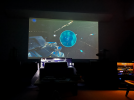jbattman1016
Active Member
- Joined
- Apr 8, 2021
- Messages
- 255
- Likes
- 126
In support of OLEDs: After having mine for over 6 months, either the panel has changed or my eyes are broken, but I find the colors and everything just perfect.
I did have to adjust a bunch of settings to get it here, but this is typical even for my previous LCD panel. I needed to spend months doing minor tweaks to get the visuals just right. So out of the box, it was very dark, but it appears to be brighter and mostly in a just use it state, which is best for the rest of the family.
I will say that the just turn on and use state for LED/LCD panels is much easier and quicker to get to.
Would I recommend an OLED panel? Depends on the person, if they like to play with settings, then I would.
I did have to adjust a bunch of settings to get it here, but this is typical even for my previous LCD panel. I needed to spend months doing minor tweaks to get the visuals just right. So out of the box, it was very dark, but it appears to be brighter and mostly in a just use it state, which is best for the rest of the family.
I will say that the just turn on and use state for LED/LCD panels is much easier and quicker to get to.
Would I recommend an OLED panel? Depends on the person, if they like to play with settings, then I would.


